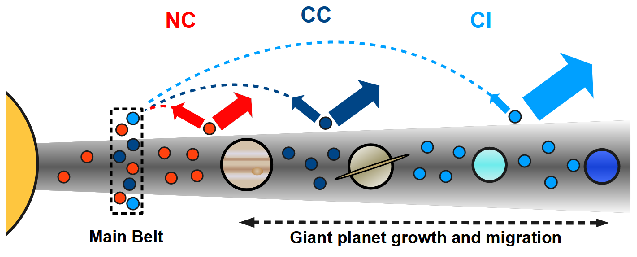DATE2022.10.21 #Press Releases
Ryuguu came from the end of the solar system.
Disclaimer: machine translated by DeepL which may contain errors.
~Lyugu's nucleosynthesis record suggests Lyugu's birthplace~.
Hokkaido University
Tokyo Institute of Technology
Graduate School of Science, The University of Tokyo
Summary of Presentations
A research group led by Professor Naoyoshi Yurimoto of the Graduate School of Science, Hokkaido University, Professor Tetsuya Yokoyama of the Department of Earth and Planetary Science, Graduate School of Science, The University of Tokyo, and Professor Shogo Tachibana of the Graduate School of Science, The University of Tokyo has revealed similarities between the Cb-type asteroid Ryugu and Ivna-type carbonaceous meteorites, and revealed that Ryugu and Ivna-type carbonaceous meteorites were very likely originated in the Urano-Neptune region. The study revealed that there is a strong possibility that Ryuguu and the Ivena-type carbonaceous asteroid were born in the Uranus-Neptune region.
Previous studies have shown that the Cb-type asteroid Ryuguu is composed of materials similar to Ivena-type carbonaceous meteorites. Ivnar-type carbonaceous meteorites are the richest type of meteorite in terms of volatile elements and have the closest composition to the elemental abundance ratios of the Sun. However, the outer regions of the asteroid belt, which are thought to have been a cold environment even at the time of the birth of the solar system, are all candidates for the birthplace of volatile element-rich Lyugu and Ivna-type carbonaceous meteorites, so the chemical similarity of the two meteorites is not a conclusive answer to the question of where Lyugu was born. The team's research team has been working on the iron isotopes.
The team measured the isotopic composition of iron and found no difference between the analytical values of Ryuguu and Ivna-type carbonaceous meteorites. The iron isotopic compositions of the Liuguu and Ivuna carbonaceous meteorites were clearly different from other carbonaceous meteorites, and a new gap appeared when the isotopic ratios of iron and titanium were plotted. This suggests that the Ryugu and Ivna-type carbonaceous meteorites originated in very different places from other meteorites.
Planets rich in volatile elements are born far from Jupiter. Cb-type asteroids such as Lyugu and Ivna-type carbonaceous meteorites were born in the Uranus/Neptune region at the outer reaches of the solar system, moved into the asteroid belt due to the gravitational resonance action of Uranus/Neptune, and then the broken pieces came to Earth, which are considered to be Ivna-type carbonaceous meteorites.
The research results were published online in Science Advances at 3:00 a.m. on October 21, 2022 (Japan Standard Time).
Figure: Schematic diagram showing the birthplace of the Ivena-type carbonaceous meteorite (CI), carbonaceous meteorite (CC), and non-carbonaceous meteorite (NC) considered in this paper. Ryugu and Ivna-type carbonaceous meteorites, which are rich in volatile materials and form a unique group with iron and titanium isotopes, are thought to have been born in the Uranus-Neptune region, further away than the other carbonaceous meteorites (from ©Hopp et al., 2022).
The following members participated in the research results.
| Shogo Tachibana | Professor, Department of Earth and Planetary Science, UTokyo Organization for Planetary and Space Science |
| Takeshi Iizuka | Associate Professor, Department of Earth and Planetary Science |
For more information, please visit the Hokkaido University website.



